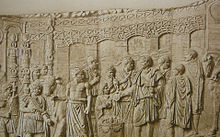Apollodorus of Damascus


Apollodor (os) of Damascus (* around 65 in Damascus , † around 130) was an important Syrian- Greek architect and civil engineer during the Roman Empire .
Life
There is no evidence of any training or early work in his home country. As an army engineer , he accompanied Emperor Trajan on his two campaigns 101/02 and 105/06 in Dacia . During this time he became its chief architect. The fact that the late antique historian Prokop describes him as an architect suggests that he was better off than the officials in the imperial service ( mechanopoios ), respected and independent. Pausania's younger contemporary notes that Apollodorus, as the state architect, directed all of Trajan's major building projects in Rome.
According to the historian Cassius Dio , after the accession of Emperor Hadrian , who became Trajan's successor in 117 , Apollodor came into a conflict with the new ruler, whose architectural and artistic ambitions he had previously derided. Cassius Dio claims that Hadrian accused the architect of the earlier insult and that he took revenge after he came to power by banishing Apollodorus. Then he sent him his plan for the Temple of Venus and the Roma to show him that a large building could be built without his cooperation. At the same time he asked the exile whether the system was correct. In his reply, the architect criticized it. The emperor was so angry about this that he had Apollodorus executed on the pretext of an alleged crime. Cassius Dio followed an unknown source whose author was hostile to Hadrian and portrayed him as a tyrant. As early as 1843, Victor Duruy stated in his Histoire romaine that the traditional description cannot apply, as Apollodorus continued to be successful in the first years of Hadrian's government. In recent research, the news of the execution is considered implausible. Ronald T. Ridley investigated the question in 1989 and identified inconsistencies which indicate that the report handed down by Cassius Dio is not plausible. Later research followed his argument.
architecture
Apollodorus is perceived as significant in terms of architectural history because he was able to merge Hellenistic- Oriental and Italian- Roman architectural forms. He took up technically traditional building materials such as bricks and mortar casting. Technically, he worked in masonry and vaulting technology. Up until his time, brick walls were regularly plastered or clad. Apollodor developed this further and partly called civil engineering on the plan. The German archaeologist Heilmeyer attests to Apollodor, clearly based on Augustan models, a "tireless separation of pattern and ground, of decor and construction, of form and function".
During the period between the years of Trajan’s campaigns between 102 and 105, Apollodor built the more than one kilometer long Trajan's Bridge over the Danube near Drobeta, together with forts and a road anchored on one side in the rock above the water level of the Danube through the so-called Iron Gate (Romanian: Portile de Fier ; see Tabula Traiana ). He may also have been responsible for the Puente de Alconétar in Spain. He also planned an academy, the Trajan's Baths (presumably identical to the gymnasium mentioned by Cassius Dio ), an odeion on a round floor plan, the arches of honor in Ancona and Benevento and above all the Trajan's markets and the Forum of the Emperor Trajan (107 to 113), the greatest Roman imperial forum. The Trajan Column in the middle of the forum is believed to be the first monument of its kind. Presumably he also designed the port of Portus Romae and that of Centumcellae with the villa of Trajan above. The architectural assignment of the rebuilding of the Pantheon to Apollodorus of Damascus, however, is controversial.
Illustrations in manuscripts
Apollodor von Damascus, Poliorketika 148: “Tortoise” Chelone , a mobile protective roof as a siege device , in the manuscript Paris, Bibliothèque Nationale , Graec. 2442, fol. 81v (11th / 12th century)
literature
- Walter Hatto Gross : Apollodorus I.9. In: The Little Pauly (KlP). Volume 1, Stuttgart 1964, Col. 440.
- Ronald T. Ridley: The Fate of an Architect. Apollodoros of Damascus . In: Athenaeum 67, 1989, pp. 551-565
- Giuliana Calcani: Apollodorus of Damascus and Trajan's Column. From tradition to project . L'Erma di Bretschneider, Rome 2003, ISBN 978-88-8265-233-3
- Burkhard Meißner : The technological literature of antiquity. Structure, tradition and effect of technical knowledge in antiquity (approx. 400 BC - approx. 500 AD). Akademie Verlag, Berlin 1999, ISBN 3-05-003194-8 , pp. 105, 106, 246–248, 257, 262, 283, 331–333, 337, 368.
- Werner Müller: Architects in the ancient world . Koehler & Amelang, Leipzig 1989, ISBN 3-7338-0096-6
- Werner Müller: Apollodoros (6) . In: General Artist Lexicon . The visual artists of all times and peoples (AKL). Volume 4, Seemann, Leipzig 1990, ISBN 3-598-22744-2 , pp. 120 f ..
Web links
Remarks
- ↑ Giuliana Calcani: Apollodorus of Damascus and Trajan's Column: From Tradition to Project , Rome 2003, p 55th
- ^ Procopius: De Aedificiis IV 6
- ↑ a b c Werner Müller: Architects in the world of antiquity . Koehler & Amelang, Leipzig 1989, ISBN 3-7338-0096-6 , pp. 134-144.
- ^ Pausanias V 12.6
- ↑ Cassius Dio 69.4.
- ^ Ronald T. Ridley: The Fate of an Architect. Apollodoros of Damascus . In: Athenaeum 67, 1989, pp. 551-565.
- ^ Anthony R. Birley : Hadrian. The restless emperor , London 1997, pp. 282 f .; James Morwood: Hadrian , London 2013, pp. 42 f., 94; Johannes Pasquali: Die Adoptivkaiser , Bochum / Freiburg 2011, p. 97.
| personal data | |
|---|---|
| SURNAME | Apollodorus of Damascus |
| ALTERNATIVE NAMES | Apollodorus of Damascus |
| BRIEF DESCRIPTION | Roman architect of the imperial era |
| DATE OF BIRTH | at 65 |
| PLACE OF BIRTH | Damascus |
| DATE OF DEATH | at 130 |


